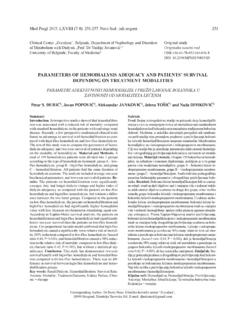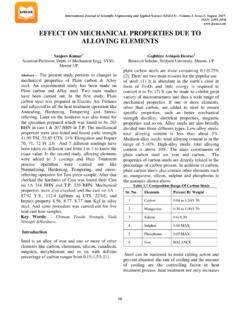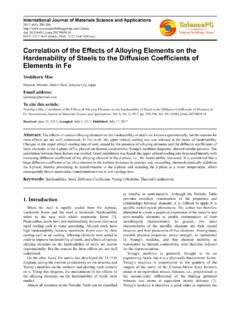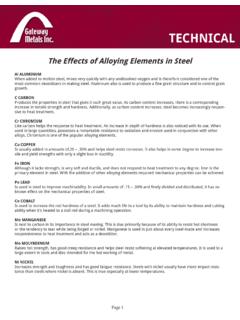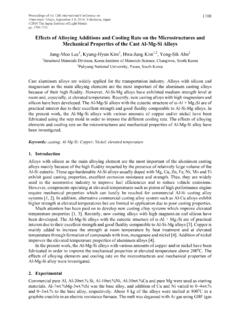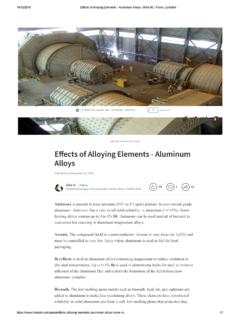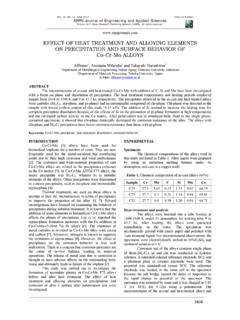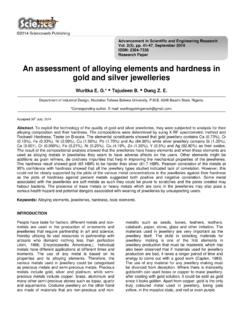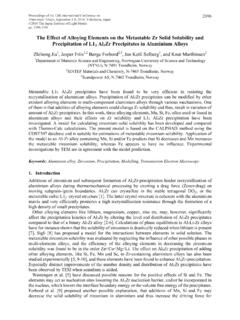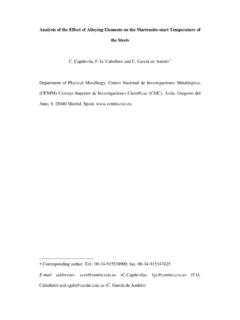Transcription of EFFECTS OF ALLOYING ELEMENTS ON ELASTIC PROPERTIES …
1 J. Min. Metall. Sect. B-Metall. 50 (1) B (2014) 37 - 44 Journal of Mining and Metallurgy, Section B: Metallurgy EFFECTS OF ALLOYING ELEMENTS ON ELASTIC PROPERTIES OF Al BY. FIRST-PRINCIPLES CALCULATIONS. J. Wang a, b, c, *, Y. Du b, Shang c, Liu c, Li b School of Metallurgy and Environment, Central South University, Changsha, Hunan, China a b State Key Laboratory of Powder Metallurgy, Central South University, Changsha, Hunan, China c Department of Materials Science and Engineering, The Pennsylvania State University, University Park, Pennsylvania, USA. (Received 16 January 2014; accepted 29 January 2014). Abstract The EFFECTS of ALLOYING ELEMENTS (Co, Cu, Fe, Ge, Hf, Mg, Mn, Ni, Si, Sr, Ti, V, Y, Zn, and Zr) on ELASTIC PROPERTIES of Al have been investigated using first-principles calculations within the generalized gradient approximation.
2 A supercell consisting of 31 Al atoms and one solute atom is used. A good agreement is obtained between calculated and available experimental data. Lattice parameters of the studied Al alloys are found to be depended on atomic radii of solute atoms. The ELASTIC PROPERTIES of polycrystalline aggregates including bulk modulus (B), shearnmodulus (G), Young's modulus (E), and the B/G. ratio are also determined based on the calculated ELASTIC constants (cij's). It is found that the bulk modulus of Al alloys 3. decreases with increasing volume due to the addition of ALLOYING ELEMENTS and the bulk modulus is also related to the total molar volume (Vm) and electron density (nAl31 X ) with the relationship of nAl X B Vm.
3 These results are of relevance to tailor the PROPERTIES of Al alloys. 31. Key words: Aluminum alloys; ELASTIC PROPERTIES ;. A3 E .. First-principles calculations; 2. changes in Al induced by ALLOYING ELEMENTS . It is known that the ELASTIC PROPERTIES of materials 1. Introduction With a density approximately one third of that of can be used to assess certain mechanical PROPERTIES steel or copper, aluminum (Al) alloys with ALLOYING such as ductility/brittleness, hardness, strength and so ELEMENTS Cu, Mg, Si, Zn, and Zr, etc, are widely used on [6]. The theoretical prediction for the effect of as engineering materials where light weight or ALLOYING additions on the ELASTIC constants (cij's) can corrosion resistance is required.
4 The PROPERTIES of Al, provide essential guidance in identifying materials which make this metal and its alloys the most with desired mechanical PROPERTIES [7]. The EFFECTS of economical and attractive for a wide variety of uses, ALLOYING ELEMENTS on the ELASTIC PROPERTIES of AlTi and are appearance, light weight, fabric ability, physical AlTi3 [8], AlNi [9], AlNi3 [10], Mg [11] and Ni [12]. PROPERTIES , mechanical PROPERTIES , and corrosion were studied via first-principles approach. These resistance [1-2]. Therefore, a detailed understanding works are important for tailoring the PROPERTIES of of the thermodynamic and ELASTIC PROPERTIES of Al existed alloys and designing new alloys.
5 In this paper, alloys is crucial for a better realization of its potential the EFFECTS of ALLOYING ELEMENTS (Co, Cu, Fe, Ge, Hf, in currently available applications and in developing Mg, Mn, Ni, Si, Sr, Ti, V, Y, Zn, and Zr) on the ELASTIC new ones. The thermodynamic modeling through PROPERTIES in the Al dilute solid solutions are predicted integrating first-principles calculations and via first-principles calculations using the efficient CALPHAD (CALculation of PHAse Diagram) stress-strain method [13]. The present work, together method has proven to be efficient and robust [3] and with the previous work [5] on the ELASTIC constants of demonstrated for relevant binary, ternary and multi- compounds, forms a basis for predicting the ELASTIC component systems of Al alloys of [4].
6 Recently, the PROPERTIES of Al alloys. It is our ambition to spark enthalpies of formation and ELASTIC PROPERTIES for systematic experimental studies of the ELASTIC binary Al compounds were systematically predicted PROPERTIES with this contribution. by first-principles calculations [5]. However, there are The rest of the present paper is described as no theoretical studies addressing the ELASTIC property follows: the details of first-principles calculations * Corresponding author: 38 J. Wang et al. / JMM 50 (1) B (2014) 37 - 44. using Vienna Ab-inito Simulation Package (VASP) set of strains = ( 1, 2, 3, 4, 5, 6) (where 1, 2 and [14-15] are presented in Section 2, including the brief 3 are the normal strains and 4, 5 and 6 are the shear introduction of equation of state (EOS) and ELASTIC strains) imposed on a crystal with lattice vectors L.
7 Theory used herein. In Section 3, The investigated specified in the Cartesian coordinates equilibrium PROPERTIES include the volume (V0), a1 a2 a3 . energy (E0), bulk modulus (B0) and its pressure L b1 b2.. b3 (2). derivative (B0') of the compounds, determined via c c EOS fitting, and the single crystal ELASTIC constants 1 2 c3 . (cij's) together with structural stabilities and the where a1, a2 2 and a3 are the x, y, z components of polycrystalline aggregates are presented and the lattice vector1a, respectively, and it is the same for discussed. Finally in Section 4, the summary of the lattice vectors b and c. After the deformation due to L. present work is given.
8 Strain , the deformed lattice vectors are obtained as follows: 1 1 6 2 5 2 .. 2. Theory and methodology First-principles calculations are performed using Ldef L 6 2 1 2 4 2 (3). 2 2 1 . the VASP [14-15] code with the projected augment 5 4 3 . wave (PAW) [16-17] method to describe the electron- Accordingly, a set of stresses, = ( 1, 2, 3, 4, 5, ion interaction and the generalized gradient 6), associated with the deformed crystal will be approximation (GGA) [18] to depict the exchange- determined through first-principles calculations in the correction functional. All the structures are fully present work. Correspondingly, for n sets of strains . relaxed with respect to cell shape, volume, and atomic (n-by-6 matrix) and the resulting stresses , the ELASTIC coordinates.
9 For consistency, a 400 eV energy cutoff constants c (6-by-6 matrix as shown in Voigt's is used for all the ELEMENTS . A 2 2 2 fcc (face- notation.) are determined according to the general centered-cubic) supercell including 31 Al atoms and Hooke's law as follows: one ALLOYING atom (X) is employed in this study. The c16 1,1 1,n . c11 c12 c13 c14 c15 1,1 1,n . 1. energy convergence criterion of electronic self- c . c21 c21 c21 c21 c21 2,1 2 ,n 2,1 2, n . consistency is chosen as 10-6 eV/atom for all the 21. calculations. The reciprocal space energy integration c31 c32 c33 c34 c35 c36 3,1 3, n 3,1 3,n .. is performed by the Methfessel-Paxton technique [19] c41 c42 c43 c44 c45 c46 4,1 4 ,n 4,1 4, n (4).
10 For structure relaxations, while the final calculations c51.. c52 c53 c54 c55 c56 5,1 5, n .. 5,1 5,n .. of total energies for EOS fittings and stresses for c61 c62 c63 c64 c65 c66 6,1 6, n 6,1 6, n . determining the cij's are performed by the linear where -1 represents the pseudo-inverse, which tetrahedron method including Bl chl corrections [20]. can be solved based on the singular value The samplings of k-point are 15 15 15 and decomposition method to get the least square 11 11 11 for EOS and ELASTIC constants calculations solutions of ELASTIC constants. Due to the symmetry of in terms of the Monkhorst-Pack [21] scheme, crystals, the minimum linearly independent sets of respectively.






